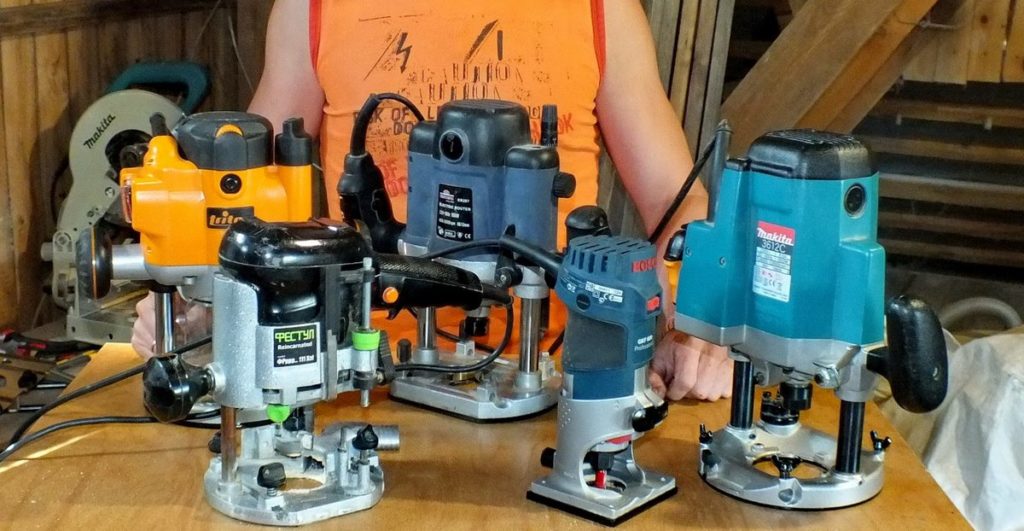Rating of the best routers for 2025

Various models of routers have become not only the most popular, but also indispensable tools in the professional environment of craftsmen. The possibilities of these units can be taken as limitless, because the device is used in almost all areas of the production of metal, composite, plastic or wood products. The first impression that is created when looking at the router (aka «RFM" - mechanical flange spreader) - the unit is a very complex machine. However, this electric tool is one of the simplest among its kind. Unlike other devices, its nozzles are mounted directly on the electric motor shaft (spindle), hence it turns out that the design is devoid of belts and gears, as well as a gearbox. Head, i.e. the power plant of this unit is capable of delivering serious power, which can be comparable even to the power of stationary equipment.Nevertheless, the developers tried to focus on the speed of movement of the nozzle, and its direct transmission allows you to disperse the cutter to stunning speeds. Any router, as a rule, is equipped with a sufficient set of optional devices that contribute to productive selection and point feed - these can be various stops, guides, templates, clamps. The highest quality requirements must be imposed on the increased functionality of these elements.

Content [Hide]
Working Principle and Applications
It is possible to process not only wood with a milling cutter - it is able to interact well with plastics, plexiglass, composite, non-ferrous metals and natural / artificial stones. Depending on a number of design properties, as well as directions of destination, it is possible to classify several types of the tool in question - from standard to specialized.However, a rod-type movable plunge mill is considered to be an extremely versatile unit. Its working head moves down / up along the guide strips of the rods, which are tightly coupled to the sole of the support. Therefore, the cutter, being in a completely vertical position, smoothly enters the material of the object being processed to a certain depth until the upper movable part comes into contact with the stop-regulator. Then the operator shifts the machine in a horizontal position, and the main task is performed by the sharpened edges of the rotating cutter.
Finishing builders, carpenters and furniture makers quickly appreciated the benefits of using the tool in question, and now it is unlikely that any stage of their professional work can do without a milling cutter. It is rather difficult to recognize its specialization as large-scale, but most of the operations that are performed through it can be unusual. However, it is worth listing the main ones:
- Quarter sample;
- Direct or figured edge profiling (for example, the manufacture of stair railings, table lids);
- Drilling any hole, incl. under pins;
- Creation of twisted / spiral and longitudinal recesses-grooves on cylindrical and conical blanks (legs or balusters);
- Grinding is rough;
- Decorative wood carving;
- Engraving works (murals on the plane or three-dimensional sculptural options);
- Arrangement of folds, slots, grooves for attaching furniture elements;
- For fitting furniture laminates flush;
- Rough trimming of contours, cutting actions, creating blanks;
- Making places for landing (locks and awnings, fittings and corners);
- Cutting spikes of various shapes for fastening / connecting workpieces;
- Manufacture of bindings (coupling of perpendicular parts of doors and windows).
Modern types of milling cutters
Vertical RFM
They are by right the best tools for processing wooden blanks. In fact, they have a traditional and classical focus, because most of the manipulations with wooden objects occur with their help. They can create curly cuts, cut grooves and niches in wooden bases. In addition, with some specialized models it is possible to create non-standard patterns and even cut complex spiked joints (for example, dovetail or straight). The main structural element of vertical aggregates is the sole, through which the aggregate is supported. On the sole there is a direction rail, which sets the stroke vector of the entire unit along the wooden part. Such a milling cutter is able to adjust the depth of its entry, which (depending on the specific model) can be from 30 to 100 millimeters. Indeed, a router is a universal device for processing wooden parts, in other words, the best choice. Read more about vertical routers here.
Edge RFM
These samples are also used for woodworking, and more specifically, they are more focused on chamfering and edges. They may also be referred to as trimmers. In size, they are slightly smaller than the vertical ones described above, which gives them more freedom of action in a limited space. Being highly specialized models, trimmers are more suitable for decoration masters who have to work hard in tight spaces.
Lamellar RFM
This equipment is used only for preparing grooves for lamellas.Occasionally, using this tool, you can make a mount in a lining for wall cladding without using plasterboard bases. Lamels are also used in the manufacture of beds and sofas. These mills have a horizontal position of the working engine. In most cases, they work exclusively on lamellas, hence it is clear why such devices are highly valued by furniture makers. If the issues of processing lamellas are not permanent, then for rare similar works you can get by with universal tools.
Corner RFM
This type of equipment is specially focused on working on artificial stone. It is used to give special geometric contours to objects made of solid materials (for example, consistent alignment of the inner radius of a stone bath bowl). For the implementation of its special functions, the device has a special stop, which prevents unauthorized processing of the walls of the product from the sides. The device is easy to operate, the processed surfaces are milled quickly and cleanly. In order to obtain a better result, it is recommended to carry out double processing - primary (roughing) and finishing (finishing).
Rotary RFM
Additionally, this type of equipment is called tiled. It is used for drilling holes in ceramic objects. The diameter of the installed collet is 8 millimeters, and the spindle speed of this small and light router can be up to 34,000 rpm. At such speeds, the risk of destroying ceramic tiles is simply reduced to nothing and the cutting element easily enters the material. Rotary models are equipped with speed controllers and can maintain its constant value even under heavy load.It is possible to connect a construction vacuum cleaner to remove dust.
Filler RFM
These units have a two-spindle design, which clearly differs from the universal equipment used for wood processing. They belong to the category of highly specialized devices. In their design, a dowel milling cutter is used, which is capable of making double holes for spikes (dowels) in furniture blanks. Then, rounded spikes lubricated with an adhesive base will be inserted into these holes, through which the connection will occur. Spring-loaded stops are located on both sides of the cutter, facilitating the precise installation of the device for drilling the next pair. The movable outdoor platform is able to rotate within 90 degrees, which allows for corner joints of workpieces. Also, this part of the base can be raised or lowered for more accurate centering of the working part relative to the end of the part. Filler RFM can be used for drilling holes in the lower-upper plane of the part. If the part is too long, then a special ruler-template should be used, on which there is a special marking in the form of cutouts located at the same distance from each other. It is in these slots that the base platform is inserted and the working part becomes possible to move the same distance.
RFM on batteries
Some of the above types of routers can run on batteries. Most often, in retail stores you can find their types: lamella and edge, straight / immersed,. For other types, the use of batteries is energy-consuming and unprofitable, and in other cases, it is structurally impossible.Nevertheless, the advantages of battery models can be called:
- This type has less weight and compact dimensions;
- The equipment will become more mobile (the movement of the operator will no longer depend on the length of the cable);
- The equipment can be used where there is no power supply.
Special Types of RFMs
For metal
These units are specially focused on the processing of metal objects, namely, they are used for cleaning post-weld seams and removing chamfers. Such a manual apparatus is mounted on guides that are sufficiently rigid and can work on both stainless and "black" steel. They can also process carbon fiber (plastic) and non-ferrous metals.
Composites
Panels made of composite materials have long been used in construction as a facing material for the facades of buildings and structures, as well as in the manufacture of outdoor advertising, etc. For cutting composite panels and for milling grooves, as a rule, a disk router is used. To obtain a better result, a special guide rail is laid on the panel and fixed with clamps. Such a tire should have a length slightly longer than the part itself. A composite RFM is placed on the guide and the desired operation is performed.
Concrete
These milling machines are used to remove various coatings from large areas. They can also be used to remove screed, old plaster, dried adhesive residue, old paintwork from walls, etc. In addition, this scraper is used for leveling and grinding concrete surfaces before applying protective materials to them.Due to the presence of a movable base plate of the machine, it is possible to achieve a smooth adjustment of the milling depth, which makes the machine's guidance on the surface more confident. These types of RFM are equipped with a comfortable D-shaped handle, which has shock-absorbing properties, due to which the negative impact on the operator's muscular system is reduced.
Specifications
Power
The power of the devices under consideration especially affects the force that is attached to the cutter, i.e. It's about "torque". The depth of cut will also depend on it. Thus, the more powerful the device, the easier it is to perform complex tasks. However, one should not think that powerful devices are ultra-fast at the same time - this is not true. Power affects only the force, but not the speed of the spindle. If it is planned to process hard wood, for example, alder or oak, and you want to make a deep cut, then powerful equipment is not suitable for these purposes. For such delicate work, increased torque is of little use.
Otherwise, a more powerful device usually has a considerable weight, hence it is clear that it is much more difficult to perform various actions with it. Also, powerful milling machines for woodworking are not cheap.
Conventionally, all RFMs can be categorized according to the following scheme:
- High-power - from 1500 W and more - heavy devices, mainly used in production and for industrial purposes (not suitable for domestic use). As an example - an ideal option for a large furniture workshop.
- Medium power - from 800-1500 W - with their help it is possible to get a deep cut and make a quarter sample. They can be used both for solving household problems and in a furniture workshop.
- Low-power - from 450-800 W - they themselves are small in size and weight and are used to perform simple tasks.
The above figures are mainly focused on vertical RFMs, due to the fact that they are the most popular due to their versatility. The power for lamella and edge devices only occasionally exceeds 900 W, so the selection of such models according to power characteristics is of little relevance. In any case, for any category of RFM, a medium power model will be considered a normal choice.
Spindle speed and stroke
The processing speed of a certain type of material directly depends on the number of revolutions per minute of the spindle. The average spindle for RFM devices is 20 - 25,000 rpm, which is enough for many types of work. However, when working with dense wood, some acceleration is required - here a speed of 30,000 rpm would be preferable. It should be noted that Asian-made devices have a fairly large variability in this indicator.
Regarding the depth of travel, it can vary from 30 to 100 millimeters. Despite the fact that it is necessary to decide in advance on how deep the future groove or niche should be. For example, if you intend to create a lock insert in the door, then a tool with a stroke depth of 80 to 100 millimeters is better suited. But for applying patterns to a wooden surface, a stroke of 50 millimeters will be enough.
Sole characteristics
The sole element can be made by casting or stamping. Stamped versions consist of several parts and are less durable than cast versions.Nevertheless, samples with stamping soles are much cheaper, therefore, if frequent use of the router is not expected, then they will turn out to be quite functional.
Soles-casting are more weighty and durable. As a rule, they are mounted on professional equipment that will be constantly in operation. If the issue of reliability and a router is at the forefront - there is a constantly used item, then you should not save on a cast sole.
Optional features and capabilities
The router can be equipped with the following options:
- Speed control - if the job is mostly going to use the same cutter size, then this option is not relevant. If the cutters will change periodically, then the device must have such an option;
- Soft start - this option limits the starting current and removes the load from the motor, so it starts without "jerks". Thus, the risk of knocking the unit out of the hands of the operator is eliminated and accidental damage to the processed object is prevented. The option becomes especially relevant if it is supposed to work with a powerful and heavy device;
- Backlight - it is designed for improved visibility of the cultivated area, in addition, it helps in the absence of a light source;
- Connecting a vacuum cleaner - some RFM models are equipped with a pipe for connecting a special vacuum cleaner or dust collector. However, dust and chips are not completely removed, but the workplace still becomes somewhat cleaner;
- Protective limiter - it is implemented in the form of a transparent ring surrounding the cutter. It is designed to protect the cutter from foreign objects entering it and at the same time protects the operator's eyes from flying chips. Most modern models have this option by default;
- Rail guide - it is also a parallel stop. It is intended for smooth eyeliner of the cutter parallel to the part. A scale can be applied to the rail, which allows you to measure the exact cutting distance down to the millimeter. This option is not mandatory, most likely it will have to be purchased separately.
Rating of the best routers for 2025
household models
4th place: "Kolner KER 1200V"
votes 0
This sample has a maximum milling depth of 50 millimeters. At the same time, the operator can use the turret type mechanism for proper multi-pass operation. The kit comes with a copy insert that serves to maintain the depth of identical grooves. Operational replacement of the cutter is simplified by a simple spindle lock. There is a speed controller - it varies from 15,000 to 30,000 rpm. A vacuum cleaner can be connected to the unit to remove chips. The recommended cost is 4200 rubles.

- Molded outsole for better foothold;
- Ability to adjust the speed;
- Quality build.
- The need for technical breaks during long-term work.
3rd place: "Hammer FRZ1200B"
votes 0
This milling device is characterized by the presence of comfortable grip handles, which are equipped with rubberized pads. The clamping screws of the device are marked with different colors, which makes it easier to identify their purpose. The depth of cut is properly adjusted. The spindle speed can be maintained automatically evenly. The recommended cost for shops is 4600 rubles.

- Intuitive and easy control;
- Adequate cost;
- Sufficient power.
- One-sided stop makes it impossible to perform some processes.
2nd place: "Bort BOF-2100"
votes 0
An extremely powerful model, which can be called semi-professional. Using this technique, it is possible to process materials that can be subjected to thermal deformation. The ability to work with such materials is provided by variable speed settings, whose lower limit is only 8,000 rpm - at such speeds, the workpiece does not have time to heat up. Nevertheless, the engine in the sample is sufficiently powerful, the collets are up to 12 millimeters. There is a soft start system that can eliminate the risk of heavy loads, which means an extended operating life. The recommended cost for the store is 6700 rubles.

- Low noise level;
- Powerful electric motor;
- Relatively small weight.
- A slight backlash is possible over time.
1st place: "Wert EVR 1450E"
votes 0
An excellent home model that perfectly combines the principle of the ratio of low price and versatility. This milling cutter can generally be used as a drill, cutter or jigsaw. Its mass is extremely small - only 3 kilograms, so that the operator's hands are not overloaded during operation. With this tool, it is easy to make furniture fittings and decorative elements for it. The set includes two collets, parallel stop, spare brushes for the electric motor. Very easy to operate. The recommended price for retail chains is 3100 rubles.

- Budget cost with wide functionality;
- Extended set of accessories;
- Excellent power.
- Not detected.
Professional Models
3rd place: Makita RP1801F
votes 0
This professional sample has an expanded energy potential, which allows you to create different groove depths in the hardest materials. The powerful motor works without overloads and provides maintenance of an optimum thermal mode. Even at low speeds, the model allows the use of large cutters, which is important when processing objects with low thermal stability. High-quality assembly from a Japanese manufacturer implies a long service life. The recommended cost for retail chains is 30,100 rubles.

- Low noise threshold;
- Powerful electric motor;
- Collet 12 mm.
- High price.
2nd place: "BOSCH POF 1400 ACE"
votes 0
This device will easily cope with the creation of template recesses for door hinges and with the application of complex decorative patterns. The Fine Deep Control speed control system will be able to provide processing with a minimum error (no more than 0.1 mm). The electronic control circuit reliably maintains the set engine speed in a uniform mode. The copy sleeve is fixed with a reliable fastening system that allows you to mount / dismantle it without much effort. Built-in electronics resists voltage fluctuations in the network and protects the motor from burnout. There is a possibility of an instant stop of work. The recommended retail price is 11,200 rubles.

- Excellent equipment;
- Instant shutdown of the mechanism;
- Smooth start;
- Precise adjustment.
- During operation, the application of slightly greater muscular effort on the part of the operator is required.
1st place: "DeWALT D 26204 K"
votes 0
An excellent example of vertical construction. Performs all functions without unnecessary noise, and accurately and quickly. There is a uniform illumination of the working area, which simplifies the processing of parts. The device has the property of speed selection, and proper adjustment of the motor anchor can dampen technical vibrations. Its light weight allows you to perform complex operations in confined spaces. The device is provided with a high-quality sawdust removal system. The recommended price for store chains is 33,000 rubles.

- Convenient case for transportation;
- Extended up to 3 years warranty;
- Possibility of using cutters up to 36 millimeters.
- High price.
Instead of an epilogue
Based on the analysis of the current market, it has been established that milling cutters are a rather isolated tool that is popular only among professionals. Hence the almost complete absence of fakes and low-quality copies on this market. Price limits and variability of kit configurations allow a potential buyer to choose equipment according to their wishes and capabilities without any problems. Still, models from well-known Asian brands are more popular, especially in the segment of household samples. Large industrial and professional RFMs cost, as a rule, 3 times more than home ones, however, they have more complete functionality and extended warranty periods. Such equipment is most often purchased for specialized furniture workshops and as the main production facilities. Their payback is not long in coming. The availability of spare parts on the market and maintenance issues are also not acute.For most brands have their own (or authorized) representative offices in all major Russian cities.
new entries
Categories
Useful
Popular Articles
-

Top ranking of the best and cheapest scooters up to 50cc in 2025
Views: 131660 -

Rating of the best soundproofing materials for an apartment in 2025
Views: 127699 -

Rating of cheap analogues of expensive medicines for flu and colds for 2025
Views: 124526 -

The best men's sneakers in 2025
Views: 124043 -

The Best Complex Vitamins in 2025
Views: 121946 -

Top ranking of the best smartwatches 2025 - price-quality ratio
Views: 114985 -

The best paint for gray hair - top rating 2025
Views: 113402 -

Ranking of the best wood paints for interior work in 2025
Views: 110327 -

Rating of the best spinning reels in 2025
Views: 105335 -

Ranking of the best sex dolls for men for 2025
Views: 104374 -

Ranking of the best action cameras from China in 2025
Views: 102223 -

The most effective calcium preparations for adults and children in 2025
Views: 102018









